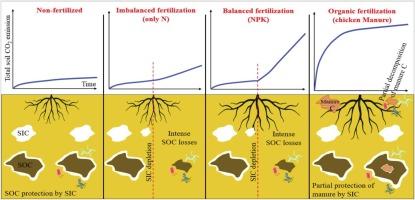Balanced fertilization management to protect soil inorganic carbon stocks and reduce soil CO2 emissions
IF 6.6
1区 农林科学
Q1 SOIL SCIENCE
引用次数: 0
Abstract
Decalcification, especially due to acidity induced by nitrogen (N) fertilization, generates an often-underestimated source of atmospheric CO2 in agroecosystems. Complete depletion of soil inorganic carbon (SIC), i.e. carbonates, intensifies the decomposition of soil organic carbon (SOC) to an extent not yet experimentally demonstrated. Six fertilization management practices including application of urea, urea + superphosphate + potassium chloride, ammonium phosphate, ammonium phosphate + potassium chloride, chicken manure along a control i.e. no fertilization were used to quantify the effects of N fertilization on soil acidification and the percentage of SIC-originated CO2 in total soil CO2 emissions. Gas samples were collected during a 56-day incubation experiment to determine total emitted CO2 and its δ13C value. The presence of SIC, kept the total CO2 emissions after inorganic fertilization at levels comparable to unfertilized soil and a balanced fertilization reduced SIC-originated CO2 emissions ( 15 % after NPK vs. 35 % with N applications) due to better nutrient use efficiency and comparatively less proton generation after nitrification. When inorganic N fertilization led to complete SIC depletion after shifting in soil pH from circumneutral (pH = 7.4) to slightly-moderately acidic pH (pH = 6.5 to about 5.8) ranges, a sudden increase in total CO2 emissions indicated the loss of the protective effects of SIC, and the extreme decomposition of the indigenous SOC. Complete depletion of SIC activates a negative feedback loop: the more fertilizer is added for more crop production, the more SOC, and soil productivity will be lost. We conclude that balanced fertilization and the use of organic fertilizers not only ensure sustainable productivity, but also significantly reduce CO2 emissions from agroecosystems by preventing SIC depletion.

平衡施肥管理保护土壤无机碳储量,减少土壤CO2排放
脱钙,特别是由于氮肥引起的酸性,在农业生态系统中产生了一个经常被低估的大气二氧化碳来源。土壤无机碳(SIC)(即碳酸盐)的完全耗竭加剧了土壤有机碳(SOC)的分解,其程度尚未得到实验证明。采用尿素、尿素+过磷酸钾+氯化钾、磷酸铵、磷酸铵+氯化钾、鸡粪6种施肥管理方式,对照不施肥,量化施氮对土壤酸化的影响以及sic源CO2占土壤总CO2排放量的百分比。在56天的孵育实验中,采集气体样品,测定CO2总排放量及其δ13C值。SIC的存在使无机施肥后的CO2排放总量保持在与未施肥土壤相当的水平,由于养分利用效率较高和硝化后质子生成相对较少,平衡施肥减少了SIC来源的CO2排放(氮磷钾处理约为15%,氮处理约为35%)。当土壤pH从环中性(pH = 7.4)转变为微中酸性(pH = 6.5 ~约5.8)时,无机氮施肥导致碳化硅完全耗竭,CO2总排放量突然增加,表明碳化硅保护作用丧失,原生有机碳急剧分解。SIC的完全耗尽激活了一个负反馈循环:为提高作物产量而添加的肥料越多,有机碳就越多,土壤生产力就会丧失。综上所述,平衡施肥和有机肥的使用不仅保证了可持续的生产力,而且通过防止碳化硅耗竭显著减少了农业生态系统的二氧化碳排放。
本文章由计算机程序翻译,如有差异,请以英文原文为准。
求助全文
约1分钟内获得全文
求助全文
来源期刊

Geoderma
农林科学-土壤科学
CiteScore
11.80
自引率
6.60%
发文量
597
审稿时长
58 days
期刊介绍:
Geoderma - the global journal of soil science - welcomes authors, readers and soil research from all parts of the world, encourages worldwide soil studies, and embraces all aspects of soil science and its associated pedagogy. The journal particularly welcomes interdisciplinary work focusing on dynamic soil processes and functions across space and time.
 求助内容:
求助内容: 应助结果提醒方式:
应助结果提醒方式:


